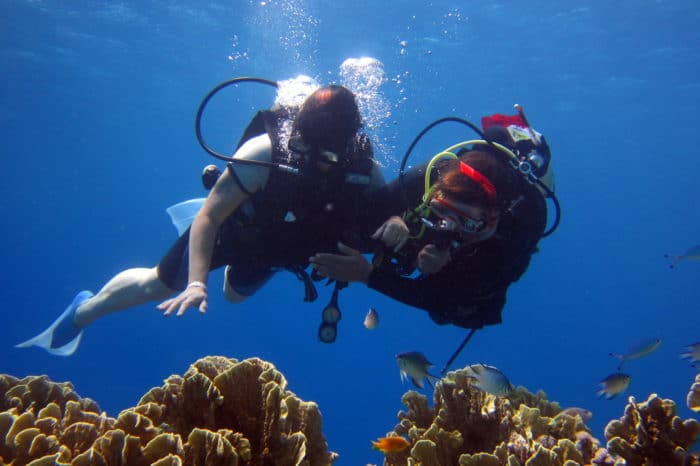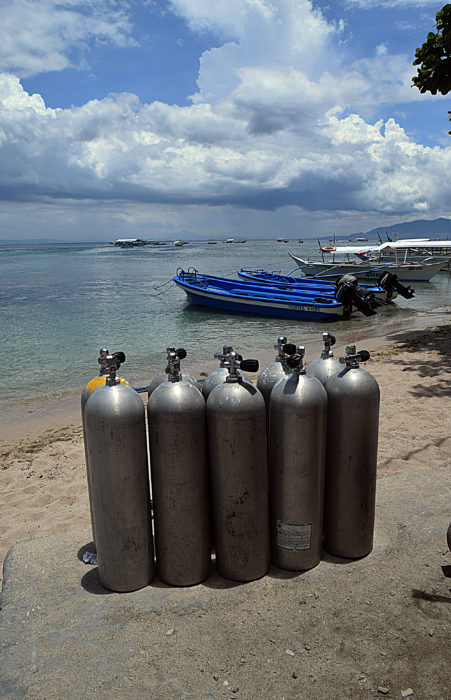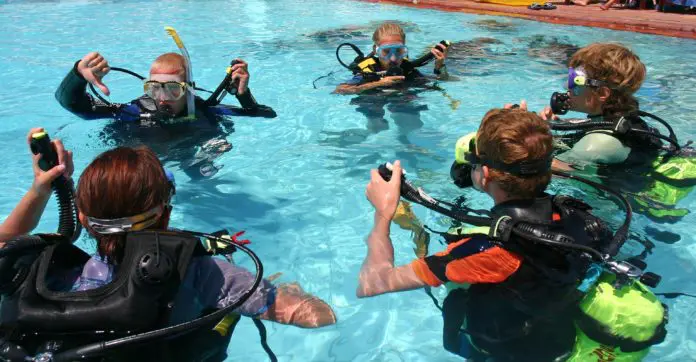Summer vacations are on just about everyone’s mind. A tropical paradise might be on your wish list or it might just be to your favorite beach. If you are on this website, you are most likely already a diver. However, there are many who visit this website who are not divers YET, or are divers and either have not dived for a while or have non-divers traveling with them. This article is geared mostly towards those that are still dreaming of their first dive.
It might be very confusing when you look at the different offerings of hotels and dive resorts. The Beginners Guide to Scuba Diving is great to use to prepare for your first dive and it a good resource for divers to review different topics. Chapter one of the guide discusses some the course titles you may come across as you start your dive training. We are going to include and reference some information found in the guide in this article as well.
What Are Your Vacation’s Diving Goals?
Know what you want and go for it. That is a great way to look at life, but often we need to refine what we want so that it is a goal that we can achieve. You may just want to experience an underwater dive and check it off your bucket list. A been there, done that activity. Others may see that same dive as accomplishing something they always wanted to do. Many want not just that first experience but are taking their first step to become a certified diver.
Introduction To Scuba Diving
This program is found under many names. Discover Dive, Try Scuba Diving and Resort Course are the most common. These are short programs that are either done in a pool or in open waters. Often hotels and resorts will offer a free program at the swimming pool, in an effort to entice people to take the open water discover dive program. These programs, in turn, are a great way to encourage people to learn how to scuba dive. The major accreditation agencies have their own version of the Introduction to Scuba diving done in open waters. The programs all follow the requirements set by the ISO 11121:2017 standards.
Just as in snorkeling, you will often see that these courses are promoted to those who do not know how to swim. Technically, there is no requirement to be able to swim to take these discovery courses. However, I personally believe that some basic swimming skills are needed. Some dive professionals who teach these course do require some swimming ability. If you are considering one of these programs and can not swim, consider taking a swimming class first. Feeling comfortable in the water will make this experience much better. There is a swimming requirement for certification courses.

The ISO 11121:2017 programs are half day programs with three elements. You start with a classroom style presentation that covers some basic knowledge and precautions necessary. The second element is the confined water portion. This could be done in a swimming pool or in shallow calm waters. Here you will be shown a few tasks that you will need to be able to do before your dive. These include how to find your regulator and replace your regulator if it comes out of your mouth. You might think that losing your regulator will not happen but it does. Mostly it happens when someone sees something that they get such a great big smile on their face the mouth opens up. Clearing water from your mask is another skill shown and practiced. Once you are comfortable with the task, you will head to open water.
The open water section is the highlight of the program. The instructor will take one or two students into the water. How long the dive last will vary between dive centers. It is a good idea to ask before you sign up, how long the open water dive will be. Some places keep it as short as 20 minutes or less. Other locations will let you dive a full tank down to a preset remaining pressure. This could give you a dive that last well over 30 minutes. The maximum depth that you can go to is 40 feet (ca. 12 meters). Many divers will tell you that the 30 feet (ca. 9 meters) to 40 feet (ca. 12 meters) range is the sweet spot for diving. You will have the best level of light and can experience many fine reefs at those depths. While you will be able to do additional dives with the same instructor without having to do the classroom and confined water skills, if you want to do it somewhere else you will need to do the entire program.
Supervised Diver
The first level of certification under the International Standards Organization is the Supervised diver as described in ISO 24801-1. Most of the accreditation agencies use the description of Scuba Diver while the CMAS system uses the term Basic Diver.
An individual certified at this level can dive to 40 feet (ca. 12 meters) when accompanied by a dive professional. This means someone who is certified as a dive master or higher. This certification is accepted worldwide. The training is a little longer than the discovery course and can be completed in two days. The supervised diver training follows the same progression and items as the first half of the autonomous diver program. You will have some classroom training, some confined water training, and two open water dives. Supervised divers can up train to be an autonomous diver by completing the second half of the course.
If you are not a frequent diver, the limits of this level of certification is not very restrictive. Most vacation destinations that feature scuba diving, will have dive masters with each group. The depth restriction is not a major concern either as it is the same as junior divers, and depth for many training dives. If your time is limited, these scuba diver courses are a great way to get started and still have time for other activities.
A personal view, many of the discover dives are overpriced. Coming back the next year and doing another discover dive will likely be more expensive than doing the scuba diver certification and coming back and diving as a certified diver. Also, as mentioned above, if you like diving, you are already half-way to your Open Water Diver certification. Think of a Scuba Diver certification as an Associates degree and the Open Water Diver as your Bachelor’s degree.

Autonomous Diver
The Autonomous Diver is described in the ISO 24801-2 standard. Open Water Diver is the most common title for this level and it is also known as CMAS 1 star for organizations using that guideline. NAUI uses the term Scuba diver for this level.
This is the certification that most divers start at. The Open Water Diver is trained to a standard that allows them to dive to a depth of 60 feet with another Open Water Diver or higher certified diver. The Open Water Diver is free to plan their own dives and as a buddy group dive without supervision up to the level of their training.
The Open Water Diver course can take up a major portion of a week’s vacation. However, there are some options available that can lessen the impact on your vacation time. You could do the knowledge portion electronically prior to your vacation, or even do both the knowledge portion and confined water sessions at home and finishing the course in tropical waters on your vacation. The article “Certification While on Vacation, Should I Start at Home? ” gives an overview of the different options to consider.
Scuba diving is an activity that can have a strong impact on your life. Once you have seen the beauty of the underwater world, your view of the world will change.

